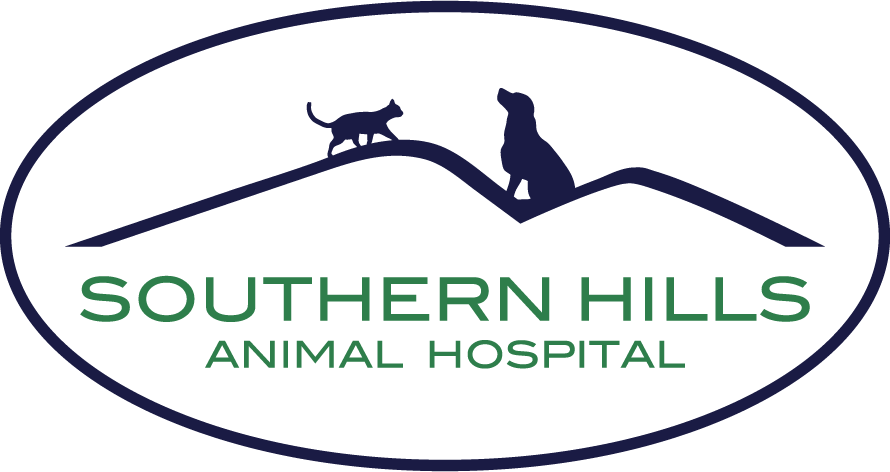Fighting obesity in pets requires two things: proper nutrition and regular exercise. With an estimated 60% of cats and 56% of dogs classified as overweight in the U.S., it is more important than ever to realize the risks involved in overindulging our pets. Just as in humans, pet obesity can lead to:
- Decreased life span
- Orthopedic pain/injury
- Diabetes
- Reduced mobility
- Cancer
- Respiratory disease
- Pancreatitis
- Kidney disease
- Fatty liver disease (cats)
- Bladder stones (cats)
The most important factor is what we feed our pets, so let’s talk about that first.
Feeding Fido & Fluffy Right
When treats and meal portions go unchecked, it fuels weight gain. Here are some tips to help your pet achieve weight-loss success:
- Determine a SET mealtime daily and do not “free feed” dogs. Allow approx. 10 min to eat, and then PICK UP the bowl. (No more feeding). If your pet doesn’t eat during that 10 minutes, they are not hungry.
- Cats can free feed, but the food should be measured out each day so your pet doesn’t overeat.
- Feed a weight loss specific food, ideally a food with grains.
- Make sure your pet is being fed the correct amount (for their IDEAL weight, NOT current weight).
- Feed pets separately so there’s no food sharing/stealing.
- Treats should contribute no more than 10% of total daily calories.
- Feeding for weight loss but not having success with your pet’s regular food? Time to try a prescription food – ask and we’ll be happy to recommend one!
- For dogs, skip evening meal a couple of times/week or prepare a smaller meal.
- For cats, skip morning meal a couple of times/week or prepare a smaller meal.
- When reducing food, begin by cutting one meal in half (decreasing total calories by ¼), continue to reduce until you have a proper food portion. Recent studies show that even feeding 10 fewer pieces of kibble per day resulted in weight loss.
- Slow down your pet’s eating with slow feed bowls, puzzle toys, or use mealtimes as a training opportunity by having the pet perform a behavior for each and every piece of kibble.
- Remember that a tiny treat means the same thing to them as a big treat, so break larger treats into smaller pieces.
- If a snack between meals is necessary, set aside a few kibbles from the daily allotment to give mid-day.
- Use a favorite toy or praise as a reward instead of treats (most prefer your attention anyway)
- Baby carrots, broccoli, zucchini, celery, asparagus & green beans are good low-calorie options for canine treats/snacks.
When it comes to table scraps and weight loss, DON’T DO IT! A little goes a long way. To a 20lb dog, 1 oz. piece of cheese is like feeding them 2 large cheeseburgers! A cup of milk to an average sized cat is like feeding 3 cheeseburgers. Check your pet’s body condition below & find more information by visiting the Association for Pet Obesity Prevention website.
Get Moving – The Second Key to a Fit Pet
The general recommendation is that dogs need at least 30-minutes of physical activity a day and cats should strive for three 5-minute intense play periods. Start out slow, and increase exercise level & intensity over time, making the events enjoyable, entertaining, and interactive. Here are more tips to incorporate activity into your pet’s day:
· Play is a great way to get exercise! Try fetch, chase, laser pointer games, boxes/paper bags for cats, puppy play dates.
· Get your steps in for the day too! Go for a walk/hike. Focus on having a brisk pace on the walk out, then you can have a more leisurely stroll on the way in.
· Pet, play, train with your pet to distract them if they are hungry—it’s good for your waistline too!
· Hide a portion of the daily food in different toys/parts of the house & have a scavenger hunt.
· Put the cat food & water bowl up on a high perch or far away from their favorite resting spot to encourage movement throughout the day.
· Invest in a pet activity monitor or app—they’re great tools for documenting your pet’s activity which you can also share with your vet.
Tracking Your Pet’s Progress
If your pet has been diagnosed as overweight, the next thing to do is work with your veterinarian to establish a long-term plan to manage your pet’s weight. Just remember that there are no quick fixes, and you must fully commit to the health of your pet.
- Steady, consistent weight loss is ideal. (0.5 – 2% of body weight/week)
- Monthly weight checks maintain motivation.
- Body Condition Scoring (BCS) is a great way to see if you pet is at an ideal weight (see chart below).
Remember on your pet’s weight-loss journey that you don’t have to go it alone; we will be with you and your furry friend every step of the way! If you have noticed any weight changes with your pet lately or would like advice to prevent weight problems from arising, please give us a call at (318) 686-5945!

